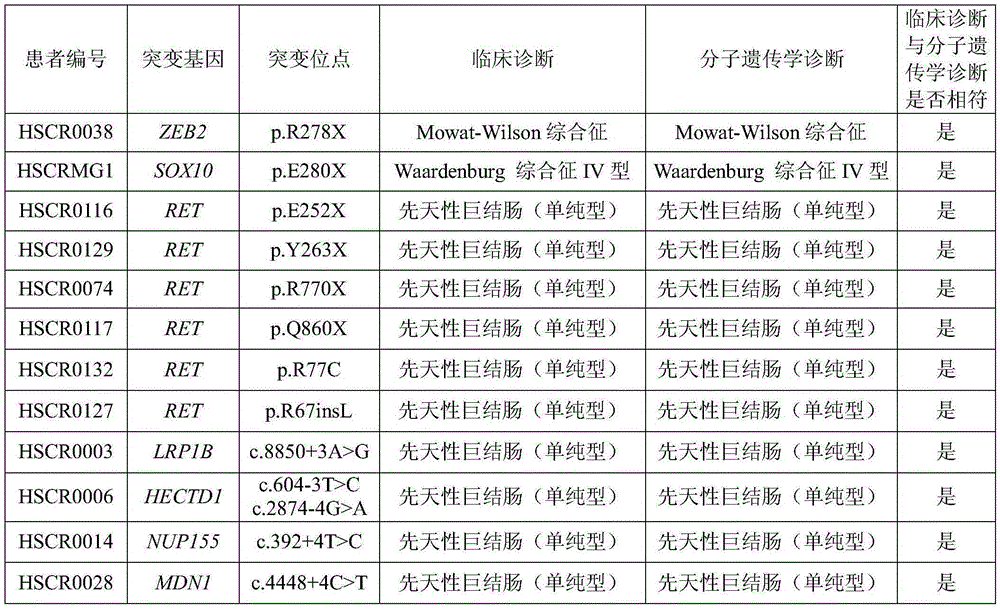Probe set and reagent kit used for detecting pathopoiesia/susceptibility genes of congenital megacolon and relative syndromes
A Hirschsprung and susceptibility gene technology, applied in the field of genetic engineering and molecular genetics, can solve problems such as lagging progress, high incidence, and hindering population quality, achieving solid theoretical basis and highly targeted effects
- Summary
- Abstract
- Description
- Claims
- Application Information
AI Technical Summary
Problems solved by technology
Method used
Image
Examples
Embodiment 1
[0065] Embodiment 1: Design and preparation of the probe set of the present invention
[0066] 1. Screening of pathogenic / susceptible genes
[0067]Based on the previous research on the results of whole-exome level genetic screening of Hirschsprung population with the largest sample size in the world, combined with a large number of database searches, screening of patient gene sequencing results, and comparison of symptoms in mouse disease models Work, finally identified 172 pathogenic / susceptible genes, mainly including four categories: (1), 15 HSCR and related syndrome pathogenic genes: RET, EDNRB, SEMA3D, SEMA3C, NRG1, PHOX2B, SOX10, ECE1 , EDN3, GDNF, KIAA1279, L1CAM, NRTN, TCF4, ZEB2; (2), literature and RNASeq results suggest 19 genes highly related to human enteric nervous system development: NAV2, WWOX, KIAA0368, PLEKHA1, MAPK10, LARGE, SYN3 , GRIN2B, LRRTM4, SOX2, NCRNA00158 (LINC00158), DLX2, GFRA1, ARAF, GRB10, HOXA2, PHACTR4, TLX2, ZIC2; (3), 120 mutations involve...
Embodiment 2
[0073] Embodiment 2: Composition, preparation and use of the kit of the present invention
[0074] The kit for detecting the pathogenic / susceptible genes of Hirschsprung and related syndromes described in this embodiment is to carry out the molecular inheritance of the individual under examination by detecting the mutations of the above-mentioned 172 pathogenic / susceptible genes. Kits for medical diagnosis or risk prediction.
[0075] The components contained in the kit are: the probe set obtained in Example 1 (160ul, 150ng / ul), enrichment buffer (208ul), hybridization buffer (800ul), binding buffer (3.2ml), washing Solution 1 (9ml), rinse solution 2 (45ml), NaOH solution (0.1M, 1ml), Tris-HCl buffer (1M, pH7.5, 1.2ml), PCR reaction solution (580ul), TE buffer (800ul ). Wherein each buffer composition is as follows:
[0076] (1) Enrichment buffer (per 20ul):
[0077] Human cot-1 DNA (purchased from Invitrogen), 7ul; salmon sperm DNA (purchased from Invitrogen), 3ul;
[00...
Embodiment 3
[0123] Embodiment 3: verification of the use effect of the kit of the present invention
[0124] Using the kit of the present invention to detect 72 samples, the results confirmed that the capture rate of the target pathogenic / susceptible gene was satisfactory, more than 97.7% of the original short sequences could be compared back to the reference sequence of the target region, and the average effective The amount of sequencing data reaches 272.4Mb, and the average sequencing depth of the target region is 263X (see Table 1), which is much higher than the general genetic disease diagnosis requirements (generally 20X).
[0125] Table 1 The quality of sequencing data for pathogenic / susceptible genes
[0126]
PUM
 Login to View More
Login to View More Abstract
Description
Claims
Application Information
 Login to View More
Login to View More - R&D
- Intellectual Property
- Life Sciences
- Materials
- Tech Scout
- Unparalleled Data Quality
- Higher Quality Content
- 60% Fewer Hallucinations
Browse by: Latest US Patents, China's latest patents, Technical Efficacy Thesaurus, Application Domain, Technology Topic, Popular Technical Reports.
© 2025 PatSnap. All rights reserved.Legal|Privacy policy|Modern Slavery Act Transparency Statement|Sitemap|About US| Contact US: help@patsnap.com



